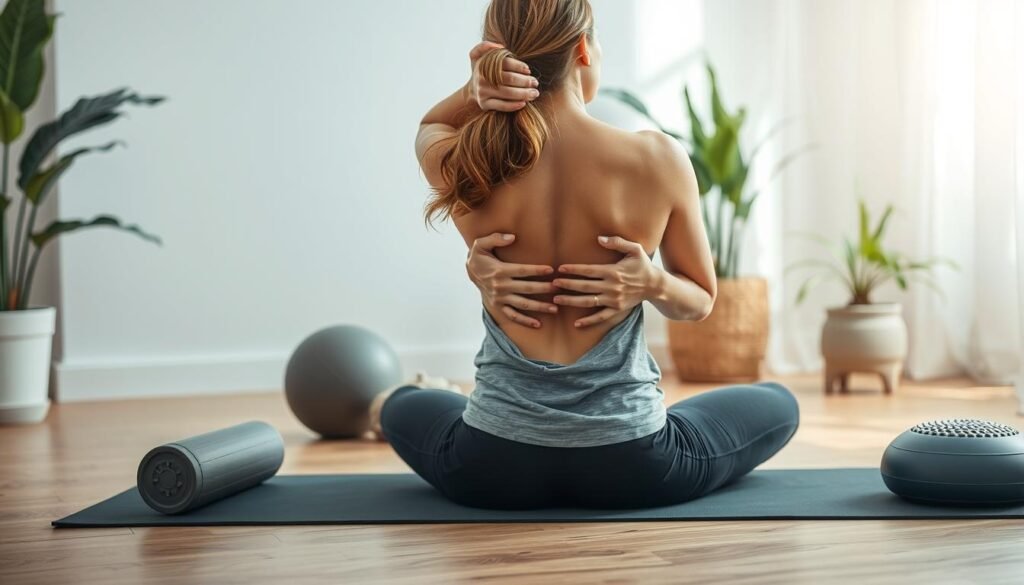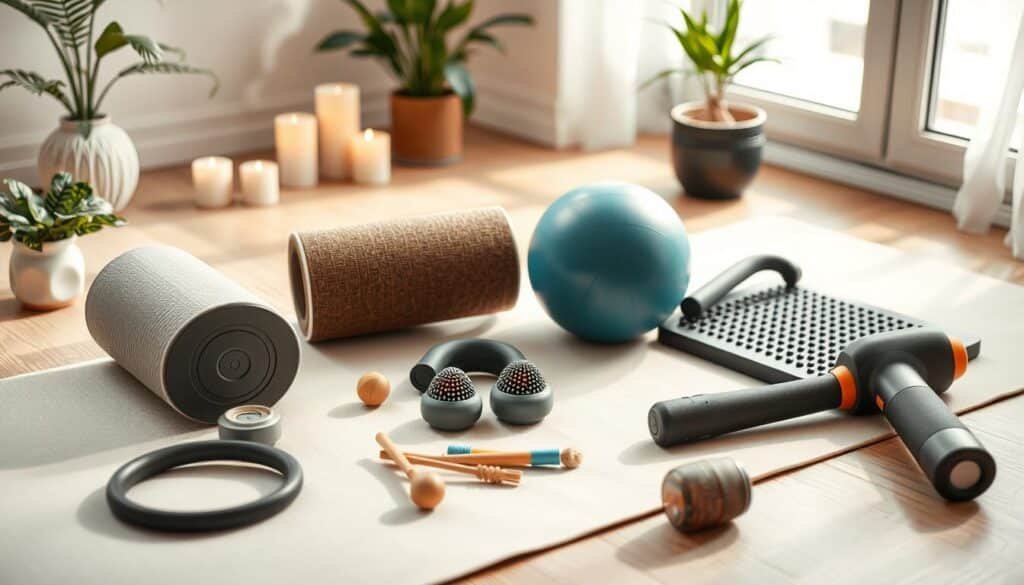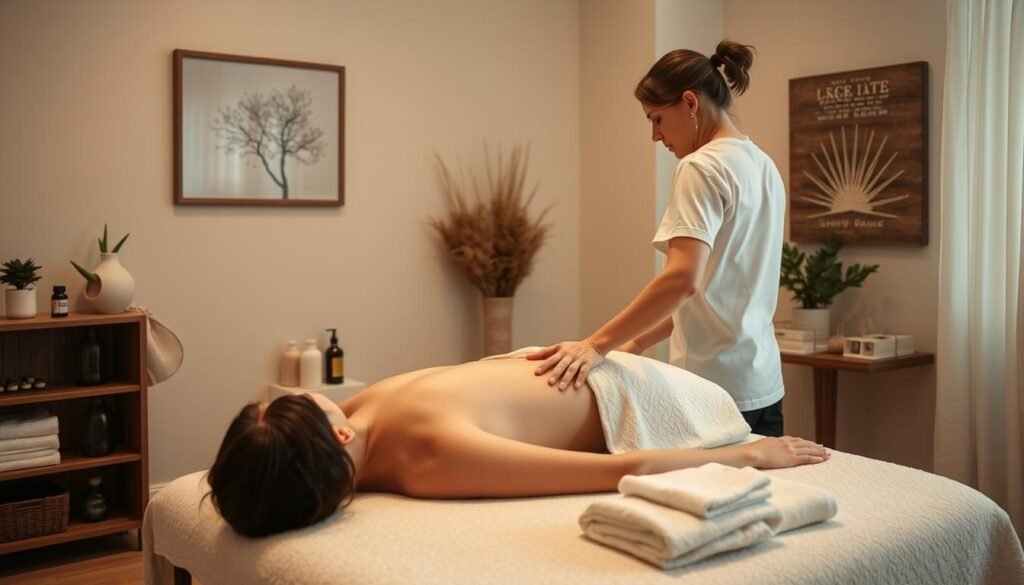Ever felt like your lower back is carrying the world? I’ve been there too. It’s really tough. But, I’m here to share some amazing massage techniques that can help.
Lower back pain is a big problem for many adults. It can come from lifting heavy things, sitting too long, or just getting older. The good news is that massage therapy is a strong way to find relief.
In this guide, we’ll look at different back massage techniques for lower back pain. We’ll cover how to massage your back yourself and when to see a professional. By the end, you’ll know how massage can be a big help against lower back pain.
Key Takeaways
- Massage therapy is an effective method for short-term lower back pain relief
- Both self-massage and professional massage options can help alleviate discomfort
- Proper techniques are crucial for maximizing the benefits of lower back massage
- Regular massage can improve daily activities affected by lower back pain
- Understanding the causes of lower back pain can help in choosing the right massage approach
Understanding Lower Back Pain: Causes and Symptoms
Lower back pain is a common problem that affects many people. I’ve been there myself, and it’s important to know what causes it. Let’s look at the causes, symptoms, and how it affects us.
Common Causes of Lower Back Pain
There are many reasons for lower back pain. Muscle strain from lifting heavy things or sudden movements is common. Sitting for long times can also cause pain. Health issues like herniated discs or arthritis play a role too.
Recognizing Symptoms of Lower Back Pain
Knowing the symptoms is the first step to treating back pain. Look out for:
- Dull aching or sharp pain in the lower back area
- Stiffness and difficulty moving
- Muscle spasms
- Pain that worsens with certain movements
Impact on Daily Life and Activities
Back pain can really disrupt our daily lives. It might make us miss work or limit what we can do. Even simple tasks can become hard. Finding the right treatment is key to living well.
| Impact Area | Acute Pain (<6 weeks) | Chronic Pain (>3 months) |
|---|---|---|
| Work | Short-term absences | Reduced productivity |
| Physical Activity | Temporary limitations | Long-term restrictions |
| Sleep | Occasional disturbances | Chronic sleep issues |
| Mental Health | Short-term stress | Increased risk of depression |
Understanding lower back pain is key to finding the right treatment. With the right approach, we can manage symptoms and feel better.
The Benefits of Massage for Lower Back Pain Relief
Massage therapy for back pain offers many benefits that can greatly improve your life. Regular massages can be a big help for those with lower back pain. Let’s look at why this ancient practice is so effective.
Massage relaxes tense muscles in your lower back. The therapist’s hands work the area, boosting blood flow. This brings fresh oxygen and nutrients, helping your body heal faster and reducing swelling.
One of the best things about massage is the release of endorphins. These natural pain-killers make you feel better right away. It’s like a reset for your body and mind.
Massage is especially good for those who sit a lot. It loosens tight muscles and helps your posture. I suggest adding lower back massage tips to your daily routine for the best results.
| Benefit | Impact on Lower Back Pain |
|---|---|
| Muscle Relaxation | Reduces tension and stiffness |
| Improved Circulation | Promotes faster healing |
| Endorphin Release | Provides natural pain relief |
| Posture Correction | Alleviates chronic pain |
Massage therapy for back pain does more than just relieve pain. It also improves sleep and boosts your immune system. Clients who get regular massages feel more relaxed and better at handling stress. This makes massage a key part of managing lower back pain.
How to Massage Lower Back Pain: Step-by-Step Guide

Lower back pain can be tough to deal with. But, learning self-massage techniques can help. I’ll show you how to prepare and do an effective lower back massage.
Preparing for a Lower Back Massage
Getting the right setup is key for a good self-massage. Choose a comfy spot like a yoga mat or firm bed. Dim the lights and play calming music to relax you. Pick a good massage oil to help your skin and reduce friction.
Essential Massage Techniques for Lower Back
Begin with soft strokes to warm up your muscles. Use your fingers or palms for circular motions. As you get to tight spots, apply more pressure. Kneading helps release tension and boosts blood flow.
Tips for Effective Self-Massage
Here are some tips to get the most out of your self-massage:
- Use a tennis ball or foam roller for deeper pressure
- Focus on breathing deeply throughout the massage
- Listen to your body and adjust pressure as needed
- Massage for 10-15 minutes daily for best results
Consistency is important for self-massage. Regularly doing it can really help your lower back.
| Massage Technique | Benefits | Duration |
|---|---|---|
| Gentle Strokes | Warm up muscles | 2-3 minutes |
| Circular Motions | Improve circulation | 3-5 minutes |
| Kneading | Release muscle knots | 5-7 minutes |
| Pressure Point Therapy | Target specific pain areas | 2-3 minutes |
Types of Massage Effective for Lower Back Pain
Many massage techniques can help with lower back pain. Each type targets different issues, making them great for pain management. Let’s look at some back massage techniques that can help with lower back problems, including sciatica.
Swedish Massage
Swedish massage is a gentle method with long strokes. It’s perfect for relaxation and easing mild back tension. This technique boosts circulation and relaxes tight muscles, ideal for beginners.
Deep Tissue Massage
Deep tissue massage is great for tough lower back pain. It uses strong pressure to reach deep muscle layers. It’s excellent for long-term back pain and breaking down scar tissue.
Trigger Point Therapy
Trigger point therapy focuses on tight muscle spots. It’s very helpful for sciatica, targeting pain sources. By applying pressure, it releases tension and eases pain in the lower back.
Myofascial Release
Myofascial release works on the fascia, the muscle’s connective tissue. It uses gentle, sustained pressure to loosen tight fascia. It’s great for chronic back pain and stiffness, improving flexibility and movement.
| Massage Type | Pressure Level | Best For |
|---|---|---|
| Swedish | Light to Medium | General relaxation, mild tension |
| Deep Tissue | Firm to Intense | Chronic pain, scar tissue |
| Trigger Point | Targeted Pressure | Sciatica, referred pain |
| Myofascial Release | Gentle, Sustained | Stiffness, limited mobility |
Massage Tools and Equipment for Lower Back Pain Relief

Using the right tools can greatly help with lower back pain. There are many options to make your massage better and help with back pain.
Tennis balls and foam rollers are great for self-massage. A tennis ball can target tight spots in your lower back. You can roll it against a wall or floor to apply pressure.
Foam rollers are good for bigger muscle groups. They help release tension along your spine.
Massage therapists use special tools for deeper tissue. These include:
- Massage guns for percussive therapy
- Wooden or plastic tools with different shapes and edges
- Heated stones for warmth and relaxation
Heat therapy tools like warm compresses or heating pads are also helpful. They increase blood flow and relax muscles, making massages more effective.
Choosing good massage oils is important. I like natural oils like coconut, jojoba, or almond oil. They reduce friction and nourish the skin, improving the massage.
Choosing the right tools can make your massages better and help with back pain. Start gently and listen to your body to avoid hurting sensitive areas.
Professional Massage vs. Self-Massage for Lower Back Pain

Managing lower back pain can be done through professional massage therapy and self-massage. Each method has its own benefits. I’ll help you understand when to choose professional help.
Benefits of Professional Massage Therapy
Professional massage therapy targets your back pain with skilled techniques. Experts can find and treat areas you might not notice. They apply the right pressure for the best relief.
Advantages of Self-Massage Techniques
Self-massage is easy and affordable. You can do it anytime, anywhere. It helps manage pain often, preventing it from getting worse.
When to Seek Professional Help
Self-massage is great, but sometimes you need a pro. If pain doesn’t go away or gets worse, see a massage therapist. Professional help is key if pain stops you from doing daily things or comes with other symptoms.
| Professional Massage | Self-Massage |
|---|---|
| Expert techniques | Convenient |
| Targeted treatment | Cost-effective |
| Access to various massage types | Frequent pain management |
| Identification of hidden problem areas | No scheduling required |
Knowing the benefits of both professional massage and self-massage helps you manage pain better. Using both can lead to the best results for back pain relief.
Complementary Treatments to Enhance Massage Benefits
Massage therapy is a great way to treat back pain. Adding other treatments can make it even better. Let’s look at some treatments that go well with massage for back pain relief.
Physical therapy is a top choice to go with massage. It helps strengthen muscles and improve flexibility. Many physical therapists also include stretches for the lower back in their plans. This helps keep the massage benefits going between sessions.
Chiropractic care is also a good option. Chiropractors adjust the spine to reduce nerve pressure and ease pain. When you add massage to this, you get faster and longer-lasting relief.
Heat and cold therapy can also boost massage results. I use heat before a massage to loosen muscles. Then, cold therapy after helps reduce swelling. This simple method can make massage pain relief last longer.
- Regular stretching exercises
- Improved posture
- Active lifestyle
- Ergonomic workspace setup
These lifestyle changes work well with massage therapy. They help manage pain over the long term. By making these changes, you’re not just treating symptoms. You’re tackling the causes of lower back pain.
| Complementary Treatment | Benefits | Frequency |
|---|---|---|
| Physical Therapy | Strengthens muscles, improves flexibility | 2-3 times per week |
| Chiropractic Care | Aligns spine, reduces nerve pressure | 1-2 times per week |
| Heat/Cold Therapy | Loosens muscles, reduces inflammation | Daily as needed |
| Stretching Exercises | Maintains flexibility, prevents stiffness | Daily |
Being consistent is important when using these treatments for back pain. Always talk to healthcare experts to make a plan that fits you best.
Post-Massage Care and Recommendations
After a soothing massage for lower back pain, I focus on proper care to maximize its benefits. Drinking plenty of water is key to flushing out toxins released during the massage. This simple step aids in recovery and helps prevent muscle soreness.
Hydration and Recovery
I make sure to drink at least 8 glasses of water throughout the day following my massage. This practice supports my body’s natural healing processes and keeps my muscles hydrated. It’s an essential part of any back pain treatment plan.
Follow-up Exercises and Stretches
To maintain the benefits of my massage, I incorporate gentle lower back stretches into my daily routine. These exercises help keep my muscles flexible and prevent tension from building up again. I find that a combination of cat-cow stretches and gentle twists work well for me.
Frequency of Massage Sessions
For ongoing relief, I schedule regular massage sessions. The frequency depends on my pain levels and daily activities. I consult with my massage therapist to determine the best schedule for my needs. This approach ensures I get consistent relief and prevents my lower back pain from returning.
FAQ
What are the common causes of lower back pain?
What are the benefits of massage for lower back pain relief?
How do I prepare for a lower back massage?
What are the essential massage techniques for lower back pain?
What types of massage are effective for lower back pain?
What tools and equipment can be used for lower back massage?
When should I seek professional help for lower back pain?
What complementary treatments can enhance the benefits of massage?
What post-massage care is recommended?
Source Links
- Lower Back Massage: Instructions, Self-Massage, Benefits, and More – https://www.healthline.com/health/back-pain/lower-back-massage
- 5 Massage Techniques to Ease Back Pain | The Physiotherapy and Rehabilitation Centres – https://www.parcofontario.com/5-massage-techniques-ease-back-pain/
- Lower Back Massage Techniques: Best Practices to Alleviate Pain — Spa Theory – https://www.spatheory.com/spa-theory-wellness-beauty-blog/lower-back-massage-techniques-and-best-practices













8 Comments
Interesting read! But wouldnt it be more beneficial to integrate yoga or pilates for long-term lower back pain relief?
Interesting read! But wouldnt yoga or physiotherapy be more effective than massage for chronic lower back pain? Any thoughts?
Has anyone tried these massage techniques and found them effective? Curious to know if they help with severe lower back pain.
Interesting read! But, do these massage techniques effectively work for all causes of lower back pain, or just some specific cases?
Effective varies person-to-person, but its no miracle cure for all back pain cases.
Has anyone tried these massage techniques for lower back pain? Im curious if theyre actually effective or just a placebo effect.
Could the article elaborate more on how to differentiate between muscle and nerve-related lower back pain symptoms?
Interesting read! But arent there any preventive measures we can take to avoid lower back pain in the first place?